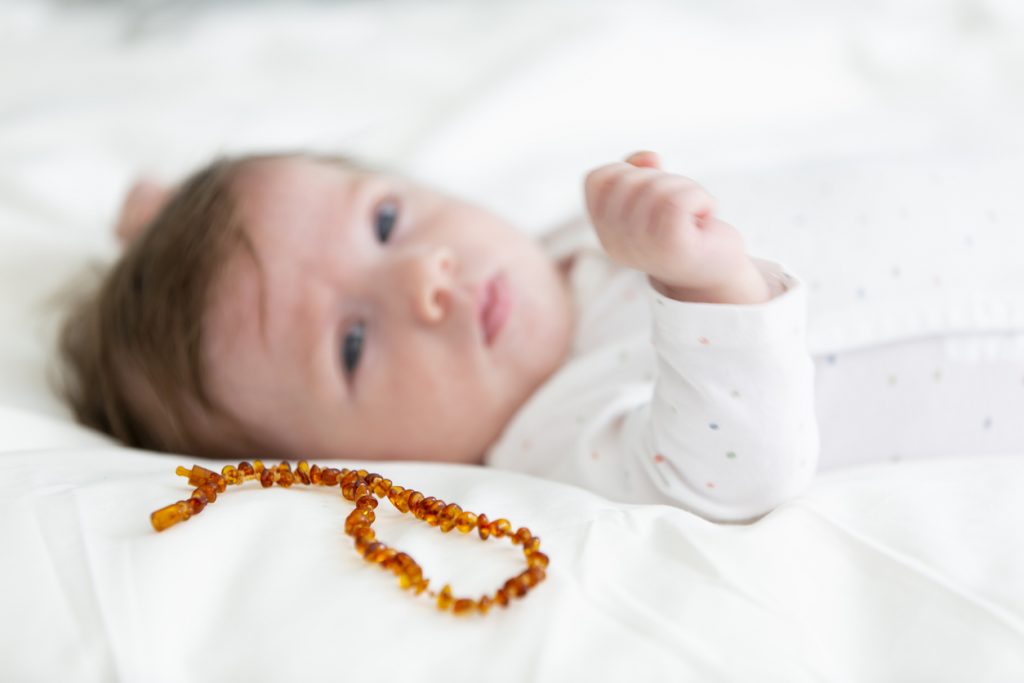Babies typically begin teething around six months of age. Usually, the front bottom two teeth emerge first, very closely followed by the front top two teeth. The appearance of the first teeth is very exciting for parents. Unfortunately, it’s also accompanied by the baby’s fussiness, drooling, chewing on firm objects, and pain from sensitive gums while their new teeth emerge. It can be frustrating for both the baby and the caregivers to deal with these symptoms. So of course parents tend to reach for comforting measures to help their little ones. Amber teething necklaces are one such measure parents have been using. It has become particularly popular after the banning of topical numbing medicines like Benzocaine in teething pain gels by the FDA.
Backed by science or just baseless claims?
Amber teething necklaces are marketed as a measure to provide relief for teething discomfort in babies. These necklaces are made of either polished or raw amber, a fossilized tree resin. Retailers claim that amber beads can relieve teething pain because amber contains succinic acid, that when absorbed by baby’s body helps to soothe sore and swollen gums. They also claim that when these necklaces are worn by the baby, the body temperature promotes the amber to release a pain-relieving substance that is absorbed by the child and helps with teething pain. The succinic acid is also touted as having “anti-inflammatory and immune-boosting” properties. The recent trend the use of Baltic amber necklaces because of the abundance of amber deposits in the Baltic regions. Also, some people believe that Baltic amber contains higher levels of succinic acid.
False claims of teething benefits
So, do amber teething necklaces really work? The short answer is NO. A 2019 study by Canadian and Australian researchers found these claims of benefit to be false. They determined that Baltic amber does not release succinic acid when worn next to the skin. It also showed that succinic acid is not an anti-inflammatory. Additionally, there have been several reports of accidental choking and strangulation incidents because of the use of these necklaces.
Choking hazard
Most hazards of the use of amber bead necklaces are associated with choking on the beads or the clasp of the necklace when the necklace breaks from pulling or tugging, or strangulation when the necklace becomes too tight around the baby’s neck in certain positions when the baby is playing or sleeping. If you are thinking about using amber bead necklaces only when watching the baby, think again. Choking and strangulation episodes take only a few seconds.
Bacteria thrives
These necklaces can also become a source of harmful bacteria or fungus. It’s natural to pick up bacteria from the baby’s surroundings. But, it then thrives on the amber due to the moistness from the drooling and the chewing on the beads. French researchers who tested amber bead necklaces in a group of babies who came to the dermatology clinic and the hospital emergency room found that all the necklaces had various types of bacteria on them.
Alternatives to amber teething necklaces
The American Academy of Pediatrics and the FDA have warned caregivers not to use amber teething necklaces for babies and toddlers. There are several safer interventions that can help relieve teething discomfort. These include massaging a baby’s gums with a clean finger or damp washcloth, providing a teething ring made of hard rubber, allowing the baby to chew on a chilled (not frozen) washcloth or teething ring. You can also give the baby an appropriate dose of Tylenol after checking with your pediatrician.
So the next time a well-meaning friend or search engine suggests amber teething necklaces for your baby, think twice. Remember that the science behind their use for teething discomfort is unconvincing, and the risks of choking and strangulation from their use is real.






Comments